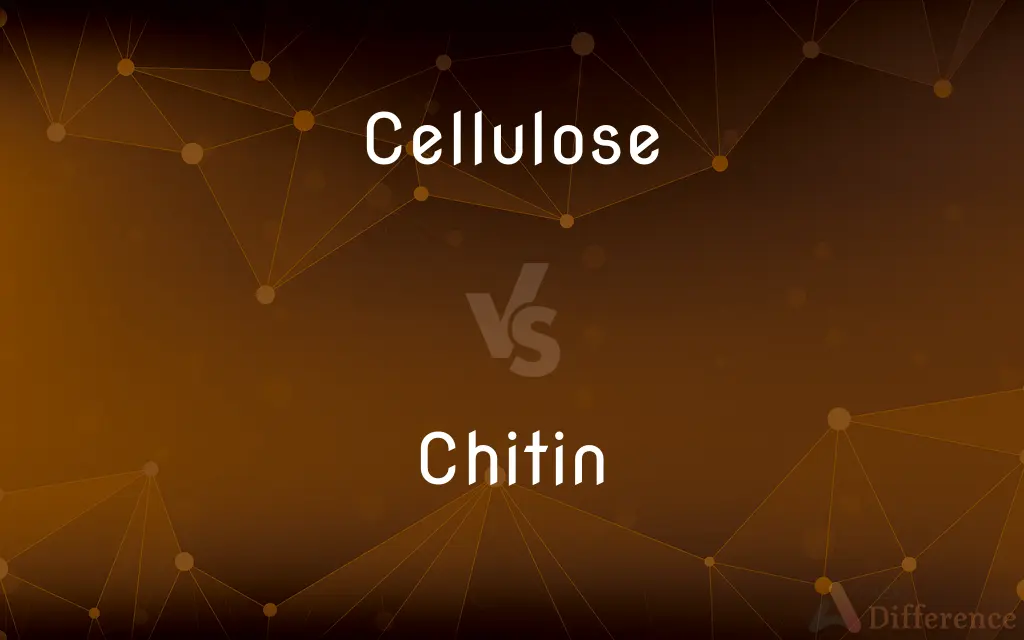Cellulose vs. Chitin — What's the Difference?
By Tayyaba Rehman & Fiza Rafique — Updated on April 17, 2024
Cellulose and chitin are both polysaccharides used structurally in nature; cellulose forms plant cell walls, while chitin is found in fungal cell walls and arthropod exoskeletons.

Difference Between Cellulose and Chitin
Table of Contents
ADVERTISEMENT
Key Differences
Cellulose is a structural component in the cell walls of plants and algae, providing rigidity and strength to the plant structure. In contrast, chitin serves a similar structural role but in the cell walls of fungi and the exoskeletons of arthropods, such as insects and crustaceans. Both are crucial for maintaining the structural integrity of these organisms, yet they are found in distinctly different biological kingdoms.
Cellulose is composed of glucose monomers linked by β(1→4) glycosidic bonds, forming long, straight chains that group together to create strong fibers. Whereas chitin is made up of N-acetylglucosamine monomers, also linked by β(1→4) bonds, but these chains fold to form a more complex structure, which is also incredibly strong but slightly more flexible than cellulose.
In the industrial world, cellulose is harvested primarily from wood and cotton to produce paper, textiles, and various cellulose derivatives like cellophane and rayon. On the other hand, chitin is commercially sourced mainly from shellfish waste and is used to produce chitosan, a material valuable in water purification, biodegradable plastics, and wound healing applications.
Cellulose is completely insoluble in water, which helps in maintaining the shape and rigidity of plant cells even when soaked. Chitin, meanwhile, also exhibits water resistance but has been found to have greater biocompatibility and biodegradability, making it preferable for biomedical applications.
Despite their structural similarities, the enzymatic digestion of cellulose and chitin is quite different due to their distinct biochemical structures. Cellulose is broken down by cellulase, an enzyme present in some microorganisms and ruminants, while chitin is degraded by chitinase, found in some bacteria, fungi, and humans.
ADVERTISEMENT
Comparison Chart
Composition
Glucose monomers
N-acetylglucosamine monomers
Bond Type
β(1→4) glycosidic bonds
β(1→4) glycosidic bonds
Structural Role
Plant cell walls
Fungal cell walls and arthropod exoskeletons
Industrial Use
Paper, textiles
Biomedical applications, bioplastics
Solubility
Insoluble in water
Insoluble in water but biodegradable
Compare with Definitions
Cellulose
Insoluble in water, aiding in the structural integrity of plants.
Despite heavy rains, the cellulose in plants prevents them from disintegrating.
Chitin
Found as a structural component in fungi and arthropods.
Mushrooms have chitin in their cell walls, similar to how insects have it in their shells.
Cellulose
Used industrially to produce paper and textiles.
The majority of paper is made from cellulose extracted from trees.
Chitin
Used to produce chitosan for various applications.
Chitin extracted from shrimp shells is processed into chitosan.
Cellulose
A complex carbohydrate consisting of glucose units, forming the main constituent of plant cell walls.
Cellulose provides plants with the necessary strength to stand upright.
Chitin
Digested by the enzyme chitinase.
Humans produce chitinase, which helps break down chitin possibly ingested from fungal sources.
Cellulose
Can be converted into derivatives like cellophane.
Cellulose is chemically altered to produce cellophane for packaging.
Chitin
A long-chain polymer of N-acetylglucosamine, a derivative of glucose.
Chitin gives strength and flexibility to the exoskeletons of insects.
Cellulose
Digested by enzymes like cellulase in certain animals.
Cows can digest cellulose thanks to the cellulase-producing bacteria in their guts.
Chitin
Insoluble in water but highly biodegradable.
Chitin is researched for use in biodegradable surgical threads.
Cellulose
Cellulose is an organic compound with the formula (C6H10O5)n, a polysaccharide consisting of a linear chain of several hundred to many thousands of β(1→4) linked D-glucose units. Cellulose is an important structural component of the primary cell wall of green plants, many forms of algae and the oomycetes.
Chitin
Chitin (C8H13O5N)n ( KY-tin) is a long-chain polymer of N-acetylglucosamine, an amide derivative of glucose. This polysaccharide is a primary component of cell walls in fungi, the exoskeletons of arthropods, such as crustaceans and insects, the radulae of molluscs, cephalopod beaks, and the scales of fish and skin of lissamphibians, making it the second most abundant polysaccharide in nature, behind only cellulose.
Cellulose
A polysaccharide, (C6H10O5)n, that is composed of glucose monomers and is the main constituent of the cell walls of plants. It is used in the manufacture of numerous products, including paper, textiles, pharmaceuticals, and insulation.
Chitin
A fibrous substance consisting of polysaccharides, which is the major constituent in the exoskeleton of arthropods and the cell walls of fungi.
Cellulose
A complex carbohydrate that forms the main constituent of the cell wall in most plants and is important in the manufacture of numerous products, such as paper, textiles, pharmaceuticals, and explosives.
Chitin
A nitrogen-containing polysaccharide that is a tough, protective, semitransparent substance and is the principal component of arthropod exoskeletons and the cell walls of certain fungi.
Cellulose
(organic compound) A polysaccharide containing many glucose units in parallel chains.
Chitin
(carbohydrate) A complex polysaccharide, a polymer of N-acetylglucosamine, found in the exoskeletons of arthropods and in the cell walls of fungi; thought to be responsible for some forms of asthma in humans.
Cellulose
Consisting of, or containing, cells.
Chitin
A white amorphous horny substance forming the harder part of the outer integument of insects, crustacea, and various other invertebrates; entomolin.
Cellulose
Consisting of, or containing, cells.
Chitin
A tough semitransparent horny substance; the principal component of the exoskeletons of arthropods and the cell walls of certain fungi
Cellulose
The substance which constitutes the essential part of the solid framework of plants, of ordinary wood, cotton, linen, paper, etc. It is also found to a slight extent in certain animals, as the tunicates. It is a carbohydrate, (C6H10O5)n, isomeric with starch, and is convertible into starches and sugars by the action of heat and acids. When pure, it is a white amorphous mass. See Starch, Granulose, Lignin.
Unsized, well bleached linen paper is merely pure cellulose.
Cellulose
A polysaccharide that is the chief constituent of all plant tissues and fibers
Common Curiosities
What are cellulose and chitin?
Cellulose and chitin are polysaccharides serving as structural components in plants and fungi/arthropods, respectively.
Where is chitin found in nature?
Chitin is found in the cell walls of fungi and the exoskeletons of arthropods.
Can humans digest cellulose or chitin?
Humans cannot digest either; however, small amounts of chitinase in humans can break down chitin to some extent.
How are cellulose and chitin similar?
Both are made of sugar units connected by β(1→4) glycosidic bonds and serve structural purposes in different organisms.
Are cellulose and chitin biodegradable?
While both are biodegradable under certain conditions, chitin is particularly noted for its biodegradability and biocompatibility.
What enzymes break down cellulose and chitin?
Cellulase breaks down cellulose, while chitinase breaks down chitin.
Where is cellulose found in nature?
Cellulose is primarily found in plant cell walls.
Is cellulose or chitin more important for human use?
Both are important, but cellulose has more widespread uses in everyday products like paper and textiles.
How are cellulose and chitin sourced commercially?
Cellulose is sourced from plant materials like wood and cotton, whereas chitin is typically extracted from shellfish exoskeletons.
What are the main uses of cellulose in industry?
Cellulose is used to produce paper, textiles, and various derivatives like cellophane and rayon.
What are the main uses of chitin in industry?
Chitin is used for producing chitosan, which is used in water purification, bioplastics, and biomedical applications.
How do the structural functions of cellulose and chitin differ?
Cellulose provides rigidity to plant cell walls, whereas chitin provides both strength and flexibility to exoskeletons and fungal cell walls.
Can both cellulose and chitin form fibers?
Yes, both can form fibers, but the fibers have different properties and uses based on their biological roles.
Why is chitin considered good for biomedical applications?
Its biocompatibility and biodegradability make chitin ideal for applications like wound healing and biodegradable plastics.
What are the environmental impacts of using cellulose and chitin?
Both materials offer environmentally friendly options; however, chitin's biodegradability offers potentially lower environmental impact, particularly in reducing plastic waste.
Share Your Discovery

Previous Comparison
Chariot vs. Car
Next Comparison
Uvula vs. EpiglottisAuthor Spotlight
Written by
Tayyaba RehmanTayyaba Rehman is a distinguished writer, currently serving as a primary contributor to askdifference.com. As a researcher in semantics and etymology, Tayyaba's passion for the complexity of languages and their distinctions has found a perfect home on the platform. Tayyaba delves into the intricacies of language, distinguishing between commonly confused words and phrases, thereby providing clarity for readers worldwide.
Co-written by
Fiza RafiqueFiza Rafique is a skilled content writer at AskDifference.com, where she meticulously refines and enhances written pieces. Drawing from her vast editorial expertise, Fiza ensures clarity, accuracy, and precision in every article. Passionate about language, she continually seeks to elevate the quality of content for readers worldwide.















































